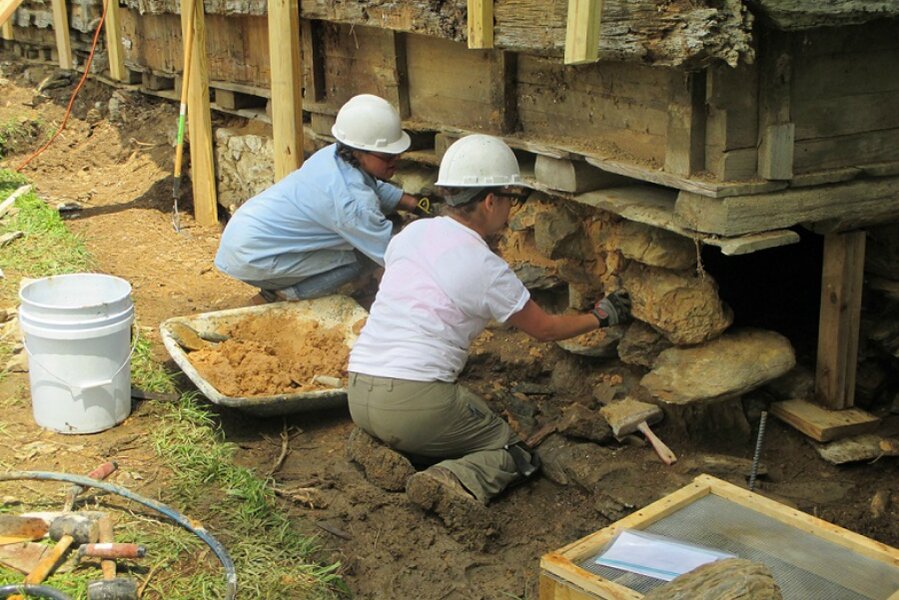HistoriCorps engages volunteers as a 'workforce for saving places'
HistoriCorps offers what some would consider an alternative vacation or escape from one’s daily routine. But it also has a bigger purpose.
“We are kind of a hybrid between a nonprofit construction company and an outdoor adventure company,” says Townsend Anderson, who has been part of HistoriCorps since 2011 and now serves as its executive director.
HistoriCorps mobilizes and engages a volunteer workforce to work on historic preservation projects on public and publicly accessible lands. Based in Denver, it manages projects throughout the country, assembling teams of volunteers and skilled tradespeople who provide training and supervision throughout a project.
“Over the course of a weekend, week, or summer volunteers have the opportunity to gain many valuable trades skills that they can apply to their personal and professional lives,” says the nonprofit group's website. While there is no fee to participate, travel to and from a project site is the responsibility of each volunteer.
HistoriCorps has been called a “workforce for saving places.” In a recent interview Anderson discussed why HistoriCorps draws volunteers.
“We are in some of the most beautiful places in North America,” he says. “We are really offering a kind of an adventure vacation, and folks [are] doing something really significant.”
Individual projects might last from a week to more than two months, though organizers are careful to break projects down into various sessions, so that volunteers can work through a given task and experience a sense of accomplishment.
“We try to construct our projects so they are volunteer friendly,” he explains. “There is a sense of accomplishment, a sense of value that they contributed something and that their work is valued.”
Projects in this summer’s lineup span the country, including work on Devil’s Head Cabin in Rampart Range, Colo., and the Mather-Klauer Lodge on Grand Island in Michigan.
To date, HistoriCorps has operated in some 20 states, with more than 170 projects completed to date through more than 50,000 hours of volunteer efforts.
Anderson says that while some projects might be hours from the nearest paved road, HistoriCorps is fully equipped to take care of volunteers.It provides all of the tools they need for work, a kitchen, and camping equipment to provide shelter as they experience the great outdoors.
“It is a way for people to see places they would otherwise not have been able to see, and spend time there,” he says, while doing important work. “We say we are saving the last great places.”
HistoriCorps came about as a partnership between a group representing land managers and preservationists, who collaborated to restore buildings on the Pike-San Isabel National Forest in Salida, Colo. That initiative helped the US Forest Service to recognize the power of such a collaborative model. The federal agency has thousands of historic buildings under its care, but it is not able to do all the preservation work that is needed.
In 2009, the first project of HistoriCorps drew some 30 volunteers who restored historic buildings in Saguache, Colo. By 2012 the organization was incorporated as its own 501(c)(3) nonprofit.
Anderson was drawn to HistoriCorps, describing it as a natural extension of his nearly 40 years spent in the historic preservation field working as a craftsman, contractor, and later a developer and owner.
Much of what HistoriCorps does is help to create a preservation ethic among those who participate, he says.
“It has really become a gateway, if you will, that historic preservation has never had before. It is introducing many non-preservationists to historic preservation,” he explains. “HistoriCorps has offered, for me, the best opportunity I have had to teach a preservation ethic.”
The most skilled craftsman could be working on a project, but it is the passion that comes with having a preservation ethic that makes the difference, he says. “Until people embrace an ethic, you are always going to be on the margins.”
Anderson admits that his own passion is shared by others who work on HistoriCorps projects, taking pride in repairing and restoring places that preserve and tell the nation's history.
HistoriCorps doesn't require volunteers to have construction or preservation experience, he says. It puts an emphasis on providing training to help volunteers accomplish their objectives.
“The volunteers are there because they want to be there, and because they learn,” he says. “Our job is to make sure they are fully engaged and enjoying it."
• For more information and to get involved, visit http://historicorps.org.






